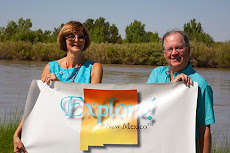
Chaco: the name evokes ancient mystery. Chaco: home to Americans from approximately 850 A.D. until 1150 A.D. Then ... so the early theories go ... they disappeared. Vanished. Of course, they didn’t. In the face of insurmountable drought, they migrated to land where they could live. They became today’s Acoma and Zuni. Those who traveled south to Paquimé live at today’s Casas Grande in Mexico. The Chacoans didn’t disappear. They are with us today.
But the mysteries surrounding Chaco persist. We came to Chaco May 15 to learn what we could about this fascinating remnant of human history. The Ranger, in his recounting, tells us they who how Chaco came to be and when, but they don’t know why.
Chaco canyon runs southeast to northwest. Water drains from higher elevations to the south into the wash that formed the mile wide canyon, cut through hundreds of feet of sandstone. The Chaco River, as the dry bed is known, when wet, drains into the San Juan and finally the Colorado. The sandstone bluffs are the result of sand bedding ancient shallow seas that covered the central part of what today is North America.
Within the canyon proper are a dozen great houses, immense stone pueblos. They range from Wijiji in the southeast about a dozen miles to Pueblo Peñasco in the northwest but high atop the bluff. This was the center of the universe for these people and it was the focus of power that controlled more than 40,000 square miles and more than 100 other pueblos across the Colorado Plateau and San Juan Basin.
With so many villages and so much land, you’d think Chaco was inhabited by tens of thousands of people. That wasn’t so. Total population ranged closer to 2,000 upwards to maybe 8,000 [and that number is contested]. Pueblo Bonito, the largest great house with over 700 rooms, may have been home to less than 200 people.
As I digest all that I saw and experienced, I will write more. But for now I have more questions than answers. I wonder about these people; who they were, why they chose this place to live and for what purpose. I am convinced something special took place here. Life wasn’t static. Society evolved over 3-1/2 centuries, more than 10 generations. The actual meaning of what when on here is lost in time.
No matter how carefully scientists search, no matter how they analyze and compare data, we will never really know the full story of chaco.
Posted by Bud Russo






Chaco Culture NHP is very nice
ReplyDeleteGood information Blog Keep Up thank
ReplyDelete